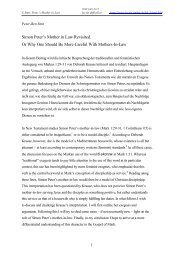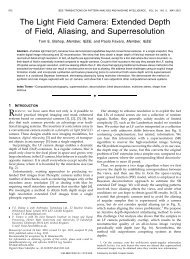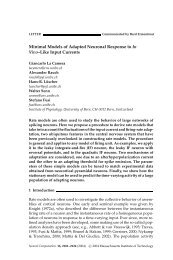Bernese GNSS Software Version 5.2 Tutorial
Bernese GNSS Software Version 5.2 Tutorial
Bernese GNSS Software Version 5.2 Tutorial
- No tags were found...
Create successful ePaper yourself
Turn your PDF publications into a flip-book with our unique Google optimized e-Paper software.
7 Additional ExamplesThe resulting summary file looks like:--------------------------------------------------------------------------------*XEPO 12 0 12*INI 0.0000 0.0000 0.0000*EST 0.0000 0.0000 0.0000*DIFXYZ 0.0000 0.0000 0.0000*DIFNEU -0.0022 0.0009 0.0000-------------------------------------------------------------------------------EPOCH DN DE DU1 -0.0051 -0.0037 0.00002 0.0046 -0.0047 0.00003 0.0015 -0.0005 -0.00004 0.0003 0.0013 -0.00005 -0.0028 0.0015 0.00006 -0.0049 0.0032 0.00007 -0.0035 0.0025 0.00008 0.0007 0.0041 -0.00009 -0.0067 0.0021 0.000010 -0.0033 0.0034 0.000011 -0.0014 0.0023 0.000012 -0.0054 -0.0013 -0.0000-------------------------------------------------------------------------------*AVG -0.0022 0.0009 0.0000*SIG 0.0039 0.0028 0.0000*RMS 0.0034 0.0028 0.0000*RMSTC 0.0011-------------------------------------------------------------------------------STATION: GANPPARAMS : 96 12 0 509 (AMB, CRD, CLK, TOT)OBSERV : 0 1592 1592The different components of the summary are described in the online help.7.2.3 Further suggestions• Introduce the result file with kinematic coordinates as an input file for another run ofGPSEST. If the estimates become zero it is a confirmation that the file was correctlyconsidered as the a priori kinematic positions for the station GANP.• Use the pre–elimination EVERY_EPOCH for the “Kinematic coordinates” (they are back–substituded by the program in order to get a solution also for those parameters).Compare the results with the first solution.• Switch the “Var–covar wrt epoch parameters” in panel “GPSEST 3.2: General Options 2”from SIMPLIFIED to CORRECT. Compare the results again with the first solution.• Compute kinematic coordinates for the full day using the epoch–wise pre–eliminationand back–substitution algorithm. To save computing power we recommend to samplethe data to 300 s.• Repeat the kinematic solution considering only one of the two <strong>GNSS</strong> at the time(choose either GPS or GLONASS in option “Satellite system” of panel “GPSEST 3.1:General Options 1”).7.3 Zero Difference Processing for Clock EstimationFor the clock estimation we have to use code and phase data together. The data is analyzedat zero difference level.Page 112AIUB
















